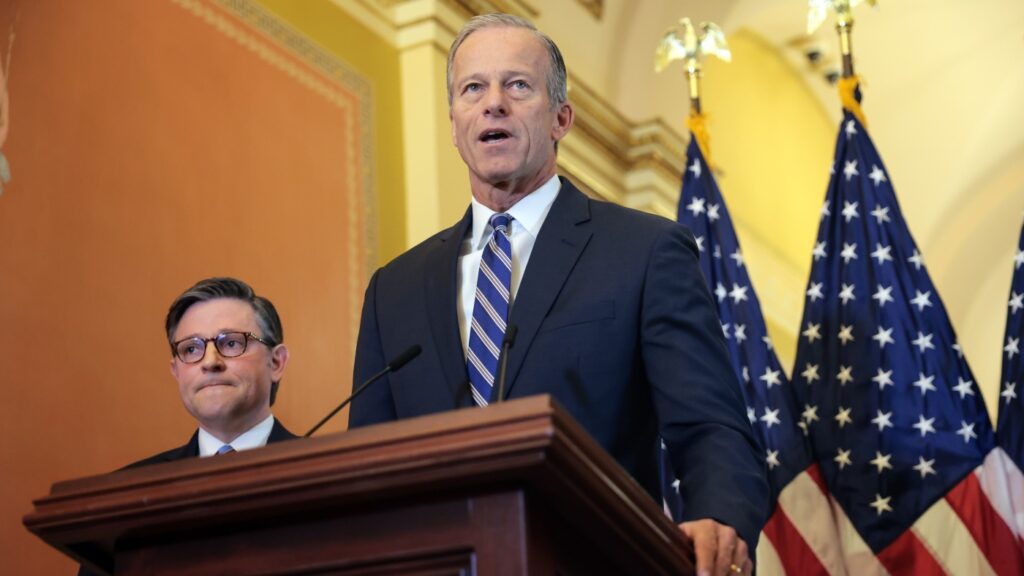
WASHINGTON, DC - APRIL 10: U.S. Senate Majority Leader John Thune (R-SD) (R) and Speaker of the House Mike Johnson (R-LA) hold a press conference on the Republican budget bill at the U.S. Capitol on April 10, 2025 in Washington, DC. The Republican leaders spoke on the reconciliation process and said they would find $1.5 trillion in cuts as the House prepares to vote on President Trump's budget outline for his tax and spending plan after Republican holdouts refused to vote without deeper cuts. (Photo by Kayla Bartkowski/Getty Images)
WASHINGTON, D.C. – Senate Republicans are poised to vote on a sweeping spending and tax cut bill, encapsulating much of President Trump’s domestic agenda, as they race against a self-imposed July 4 deadline.
Breaking: Key Details Emerge
The Senate’s updated version of the legislation mirrors many policies that narrowly passed in the House of Representatives in May. It features an extension of Trump’s 2017 tax cuts and increased funding for border security, defense spending, and energy production. Republican leaders are aiming to initiate votes on the measure by Saturday, with the potential for amendments extending the process into Sunday.
Senate Republicans propose raising the debt limit by $5 trillion, surpassing the House’s $4 trillion proposal.
Immediate Impact
Where Republicans remain divided is in financing these priorities. Despite similar toplines, the Senate’s proposal introduces several changes from the House bill, notably a higher debt limit increase and significant Medicaid modifications. The Senate Parliamentarian, Elizabeth MacDonough, has advised on necessary adjustments to comply with reconciliation rules, leading to the removal of certain provisions.
Industry Response
The bill is expected to encounter resistance from various party factions, particularly fiscal conservatives concerned with deficit reduction and lawmakers opposing cuts to social safety net programs. Internal debates over the nation’s borrowing limit persist, with Sen. Rand Paul of Kentucky vowing opposition.
“Without lifting the debt cap, the U.S. risks default, a scenario economists warn could be catastrophic globally,” according to the Congressional Budget Office.
Tax Incentives and Changes
The bill incorporates many of Trump’s tax-related campaign promises, including temporary deductions for tip wages and overtime pay, with reductions for higher earners. The child tax credit increases slightly, and the standard deduction is permanently expanded. These differ from the House’s temporary measures.
By the Numbers
- Child tax credit increase: $2,000 to $2,200
- Standard deduction for seniors: $6,000
- Debt limit increase: $5 trillion
Background Context
The bill’s provisions also cover border security, allocating $46.5 billion for Trump’s border wall and additional funds for security enhancements. New immigration fees are introduced, albeit with some adjustments following parliamentary advice.
Changes to SNAP
Both legislative chambers propose reforms to the Supplemental Nutrition Assistance Program (SNAP), emphasizing expanded work requirements and state cost-sharing. These changes are slated for 2028 implementation.
What Comes Next
While some GOP Senators express concerns, the primary challenge may lie in the House, which must approve the same bill if passed by the Senate. The legislation’s development is ongoing, with negotiations continuing up to the last minute.
The Senate bill calls for $4 trillion in tax cuts, slightly exceeding the House’s $3.8 trillion.
Future Implications
As the Senate prepares for a pivotal vote, the outcome will significantly influence both domestic policy and party unity. The implications of the legislation will be closely monitored, with potential impacts on the national deficit and social programs.
Stay tuned as this story develops and further details emerge from Capitol Hill.






